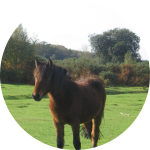| Home |
Welcome to the Horse Stall |
|
Horse Stall contains all types of information for Horse Lovers.
There are a number of products branded horse gifts and products.
Horse Articles :: Horse Breeds Glossary - S
|
Horse Breeds Glossary - S |
|
SHETLAND PONY The oldest breed of horse found in Britain, the Shetland Pony is named after the islands where it was first originated. Shetland Ponies are the most popular ponies around the world. Most people believe the ponies are so shaggy because of conditioning by their environment as the Shetland Islands are barren with a harsh climate. For hundreds of years, Shetland Ponies lived wild; right out in the open and protected from the environmental elements by their thick hair and mane. Islanders eventually domesticated the ponies so that they could help with various work and tasks. Shetland Ponies often carried peat from bogs to Scottish cottages for fuel; and they carried seaweed from the shore to the fields in order to fertilize the ground. Appearance Shetland ponies are extremely strong in relation to their size; but both stallions and mares are extremely gentle and docile. Their bodies are full, with short and musclar legs. They have thick hair and manes, as well as a long, thick tail. Many colors can be found among Shetland Ponies, but most commonly they are black and dark brown. Shetland Ponies are mostly used as pets, but some are in competition for weight-pulling events, halter classes, and carriage riding. They are between 9.3 and 10.2 hands. Coal Ponies Shetland Ponies were used in the coal mining industry in Britain during the 1800's because of their great strength despite their small size. some ponies were actually born in the mines- and were never brought out! In the 1900's mechanization caused Shetland Ponies to be considered inefficient in the coal mines. SHIRE HORSE While no one knows exactly where the Shire breed originated, there are some theories of their beginnings. England is most likely the origination location; and if they were not the first breeders of the Shire horse; they at least were responsible for producing them. The horses have strength and courage, and discipline that made them great Britain war horses. Shire horses are sometimes referred to as the English Great Horse, and many believe that the strongest horses in England are all somehow related to the Shire breed. The government of england for years aimed to increase the size and number of horses in the Shire breed, likely to be able to carry soldiers who wore armor weighing over 400 pounds! Blending of horses in the lowlands of Flanders of Holland with the horses in elbe have resulted in England's heaviest horses. Most are black with white markings over their faces and feet, and some have white markings on their legs as well. From 1509 to 1547, during the reign of Henry VIII, the raising and breeding of strong horses was priority and laws were passed to encourage it. In Scotland, during 1535 and 1541, people were not allowed to breed horses under 15 hands in height. The Shire was a national treasure of a horse, particularly in the 1800's. High in demand for decades, the large horses with great strength were necessary to fulfill the needs of empire and war. SKYROS-PONY A Greek Pony variety, the Skyros Pony is found throughout Greece and is used for riding and as a draft pony. They are white, bay, gray or dun in color and nearly extinct. SOMALI-PONY First originated in teh east African country of Somalia, the pony with the same name has numerous varieties including Dor, Nogali, Mijertinian, and Daror. The Somali Pony is rare. SORRAIA HORSE Sorrai horses come from the wild horses of souther Iberia. They are about 14 hands tall, and have ancestry with Andalusia and Lusitania horses as well as horses in Europe and America. The Sorraia horses were captured and taught to ride, as well as to heard fighting bulls and livestock. At this time, Sorraia horses are almost extinct, with only a few herds maintained in Germany and Portugal. They are noted for their ability to adapt to extreme climates, including dry and hot climates; as well as the ability tolive on very litle food and still remain healthy. For awhile, Sorraia were very valuable to stockmen. Documents show that the Sorraia horses were taken to America by Spanish conquistadors, and the bloodlines are evident in several breeds found in North and South America. Some American Mustang DNA is similar, and some patterns identical to the DNA patterns of teh Sorraia. Their colors are always dun or grullo, and they have dark faces with a black dorsal stripe. Often, Sorraia horses have stripes on their legs resembling zebras. Pure Sorraia do not have white markings, and doesn't show any Oriental or North European horse bloodlines. The foals are born with zebra stripes all over that fade as they grow older. About the Author |
Top Horses |
|
| Top Horse Movies | |
Horse Resources |
|
Horse Health |
|
Horse Breeds |
|
More Horses |
|


| Copyright 2005-2021 DR Management All rights reserved |
Dog Gifts | Wildlife Gifts | Handmade Horse Gifts |
